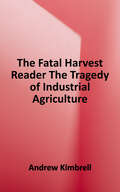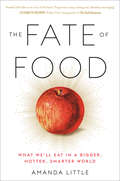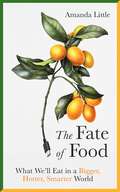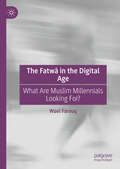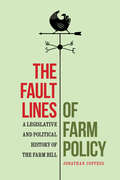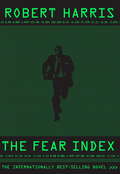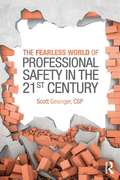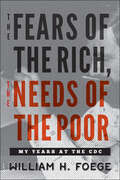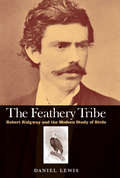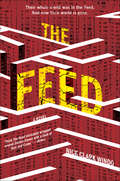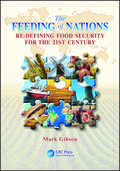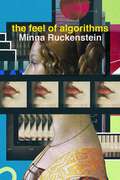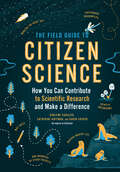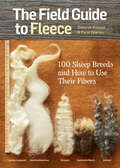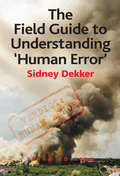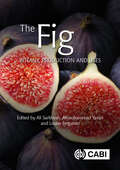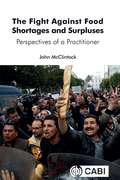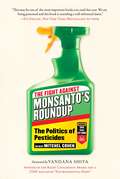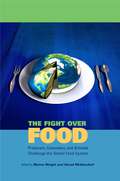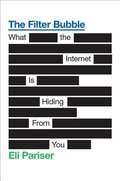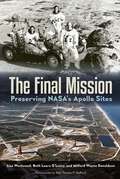- Table View
- List View
The Fatal Harvest Reader: The Tragedy of Industrial Agriculture
by Andrew KimbrellThis book takes an unprecedented look at our current ecologically destructive agricultural system and offers a compelling vision for an organic and environmentally safer way of producing the food we eat. It gathers together more than forty essays by leading ecological thinkers including Wendell Berry, Wes Jackson, David Ehrenfeld, Helena Norberg-Hodge, Vandana Shiva, and Gary Nabhan. Providing a unique and invaluable antidote to the efforts by agribusiness to obscure and disconnect us from the truth about industrialized foods, it demonstrates that industrial food production is indeed a "fatal harvest"--fatal to consumers, fatal to our landscapes, fatal to genetic diversity, and fatal to our farm communities. As it exposes the ecological and social impacts of industrial agriculture's fatal harvest, Fatal Harves t details a new ecological and humane vision for agriculture. It shows how millions of people are engaged in the new politics of food as they work to develop a better alternative to the current chemically fed and biotechnology-driven system. Designed to aid the movement to reform industrial agriculture, Fatal Harvest informs and influences the activists, farmers, policymakers, and consumers who are seeking a safer and more sustainable food future.
The Fate of Food: What We'll Eat in a Bigger, Hotter, Smarter World
by Amanda LittleIn this fascinating look at the race to secure the global food supply, environmental journalist and professor Amanda Little tells the defining story of the sustainable food revolution as she weaves together stories from the world's most creative and controversial innovators on the front lines of food science, agriculture, and climate change.Climate models show that global crop production will decline every decade for the rest of this century due to drought, heat, and flooding. Water supplies are in jeopardy. Meanwhile, the world's population is expected to grow another 30 percent by midcentury. So how, really, will we feed nine billion people sustainably in the coming decades? Amanda Little, a professor at Vanderbilt University and an award-winning journalist, spent three years traveling through a dozen countries and as many U.S. states in search of answers to this question. Her journey took her from an apple orchard in Wisconsin to a remote control organic farm in Shanghai, from Norwegian fish farms to famine-stricken regions of Ethiopia. The raise to reinvent the global food system is on, and the challenge is twofold: We must solve the existing problems of industrial agriculture while also preparing for the pressures ahead. Through her interviews and adventures with farmers, scientists, activists, and engineers, Little tells the fascinating story of human innovation and explores new and old approaches to food production while charting the growth of a movement that could redefine sustainable food on a grand scale. She meets small permaculture farmers and "Big Food" executives, botanists studying ancient superfoods and Kenyan farmers growing the country's first GMO corn. She travels to places that might seem irrelevant to the future of food yet surprisingly play a critical role—a California sewage plant, a U.S. Army research lab, even the inside of a monsoon cloud above Mumbai. Little asks tough questions: Can GMOs actually be good for the environment—and for us? Are we facing the end of animal meat? What will it take to eliminate harmful chemicals from farming? How can a clean, climate-resilient food supply become accessible to all? Throughout her journey, Little finds and shares a deeper understanding of the threats of climate change and encounters a sense of awe and optimism about the lessons of our past and the scope of human ingenuity.
The Fate of Food: What We’ll Eat in a Bigger, Hotter, Smarter World
by Amanda LittleIs the future of food looking bleak – or better than ever? At a time when every day brings news of drought and famine, Amanda Little investigates what it will take to feed a hotter, hungrier, more crowded world. She explores the past along with the present and discovers startling innovations: remote-control crops, vertical farms, robot weedkillers, lab-grown meat, 3D-printed meals, water networks run by supercomputers, cloud seeding and sensors that monitor the microclimate of individual plants. She meets the creative and controversial minds changing the face of modern food production, and tackles fears over genetic modification with hard facts. The Fate of Food is a fascinating look at the threats and opportunities that lie ahead as we struggle for food security. Faced with a perilous future, it gives us reason to hope.
The Fatwā in the Digital Age: What Are Muslim Millennials Looking For?
by Wael FarouqThe rise of a significantly large (and young) Muslim population in the West, possessing no historical tradition of being a minority in a non-Muslim environment, has led to a recurring debate about the integration of Muslims into Western societies and the compatibility of Islam with Western values. The proliferation of Islamic sites to which thousands of Western Muslims turn to request a fatwa, i.e. a religious legal opinion on any issue, hints at the urgency felt by these Muslims to find a way out of this conflictual dialectic, since most of their questions concern precisely how to reconcile Islamic principles with some aspect of modern life in the West. The pervasiveness of these internet fatwas is a striking phenomenon worth of study that can help finding answers to the longstanding debate about the integration of Muslims in the West and in modern societies. raising interesting questions: What do Muslims in Western societies ask these virtual muftis and why? Who are they? What are their desires and concerns? In their asking, are these Muslims seeking integration or separation? Do these questions reflect common clichés about Muslims, as conveyed by some Western media narratives or not? Do they reason as individuals or as members of a religious community? This book presents a scientific study aimed at answering these questions through a statistical and discourse analysis of a large corpus of more than ten thousand fatwa questions extracted from the huge fatwa databases available on the internet.
The Fault Lines of Farm Policy: A Legislative and Political History of the Farm Bill
by Jonathan CoppessAt the intersection of the growing national conversation about our food system and the long-running debate about our government’s role in society is the complex farm bill. American farm policy, built on a political coalition of related interests with competing and conflicting demands, has proven incredibly resilient despite development and growth. In The Fault Lines of Farm Policy Jonathan Coppess analyzes the legislative and political history of the farm bill, including the evolution of congressional politics for farm policy. Disputes among the South, the Great Plains, and the Midwest form the primordial fault line that has defined the debate throughout farm policy’s history. Because these regions formed the original farm coalition and have played the predominant roles throughout, this study concentrates on the three major commodities produced in these regions: cotton, wheat, and corn. Coppess examines policy development by the political and congressional interests representing these commodities, including basic drivers such as coalition building, external and internal pressures on the coalition and its fault lines, and the impact of commodity prices. This exploration of the political fault lines provides perspectives for future policy discussions and more effective policy outcomes.
The Fear Index (Bride Series)
by Robert HarrisAt the nexus of high finance and sophisticated computer programming, a terrifying future may be unfolding even now. Dr. Alex Hoffmann's name is carefully guarded from the general public, but within the secretive inner circles of the ultrarich he is a legend. He has developed a revolutionary form of artificial intelligence that predicts movements in the financial markets with uncanny accuracy. His hedge fund, based in Geneva, makes billions. But one morning before dawn, a sinister intruder breaches the elaborate security of his lakeside mansion, and so begins a waking nightmare of paranoia and violence as Hoffmann attempts, with increasing desperation, to discover who is trying to destroy him. Fiendishly smart and suspenseful, The Fear Index gives us a searing glimpse into an all-too-recognizable world of greed and panic. It is a novel that forces us to confront the question of what it means to be human--and it is Robert Harris's most spellbinding and audacious novel to date.
The Fearless World of Professional Safety in the 21st Century
by Scott GesingerProfessional safety is in danger of extinction. Safety professionals have become complacent and unfocused, ignorantly relying on an 80-year-old paradigm. Lazy gimmicks are substituted for the hierarchy of controls meant to be the foundation of the profession. A $10,000 investment in posters makes zero improvement in safety; a $10,000 investment in machine guarding upgrades can save lives. By blending philosophy, history, and psychology, The Fearless World of Professional Safety in the 21st Century is revolutionary, offering an innovative approach with creative solutions to move a safety program past the malarkey that has devalued professional safety for decades. Using humor and professional experience within a discussion of historical events and published scientific findings, Scott Gesinger explores the history of how current safety practices developed and why these must change if the profession is to survive the 21st century. He discusses new professional philosophies based on best practices in industry, historical examples, scientific research outside of safety, and proven approaches from other disciplines which can successfully guide safety professionals into the future. Gesinger provides a book for every safety professional that is candid, plain-speaking, and eminently approachable, while at the same time provides information that is new, challenging, and engaging.
The Fears of the Rich, The Needs of the Poor: My Years at the CDC
by William W. FoegeWilliam H. Foege, one of the most respected leaders in global public health, takes readers on a tour of his time at the CDC.In its seventy years, the Centers for Disease Control and Prevention (CDC) has evolved from a malaria control program to an institution dedicated to improving health for all people across the world. The Fears of the Rich, The Needs of the Poor is a revealing account of the CDC’s development by its former director, public health luminary William H. Foege.Dr. Foege tells the stories of pivotal moments in public health, including the eradication of smallpox (made possible due in part to Foege’s research) and the discovery of Legionnaires’ disease, Reye syndrome, toxic shock syndrome, and HIV/AIDS. With good humor and optimism, he recounts the various crises he surmounted, from threats of terrorist attacks to contentious congressional hearings and funding cuts. Highlighting the people who made possible some of public health’s biggest successes, Foege outlines the work required behind the scenes and describes the occasional tensions between professionals in the field and the politicians in charge of oversight. In recent years, global public health initiatives have come from unanticipated sources. Giants in the field now include President Jimmy Carter and his wife, Rosalynn, who promote programs aimed at neglected diseases. Melinda and Bill Gates have invigorated the field through research and direct program support, especially in the area of vaccine-preventable diseases. And the Merck Mectizan program has dramatically reduced river blindness in Africa. Foege has been involved in all of these efforts, among others, and he brings to this book the knowledge and wisdom derived from a long and accomplished career. The Fears of the Rich, The Needs of the Poor is an inviting but unvarnished account of that career and offers a plethora of lessons for those interested in public health.
The Feathery Tribe
by Daniel LewisAmateurs and professionals studying birds at the end of the nineteenth century were a contentious, passionate group with goals that intersected, collided and occasionally merged in their writings and organizations. Driven by a desire to advance science, as well as by ego, pride, honor, insecurity, religion and other clashing sensibilities, they struggled to absorb the implications of evolution after Darwin. In the process, they dramatically reshaped the study of birds. Daniel Lewis here explores the professionalization of ornithology through one of its key figures: Robert Ridgway, the Smithsonian Institution’s first curator of birds and one of North America’s most important natural scientists. Exploring a world in which the uses of language, classification and accountability between amateurs and professionals played essential roles, Lewis offers a vivid introduction to Ridgway and shows how his work fundamentally influenced the direction of American and international ornithology. He explores the inner workings of the Smithsonian and the role of collectors working in the field and reveals previously unknown details of the ornithological journalThe Aukand the untold story of the color dictionaries for which Ridgway is known.
The Feed: A Novel
by Nick Clark WindoNick Clark Windo’s “The Feed examines our addiction to technology through the lens of a bleak dystopia . . . A deft and extremely clever work of sci-fi.”*The Feed is accessible everywhere, by everyone, at any time. It instantaneously links us to all information and global events as they break. Every interaction, every emotion, every image can be shared through it; it is the essential tool everyone relies on to know and understand the thoughts and feelings of anyone and everyone else in the world. Tom and Kate use the Feed, but Tom has resisted its addiction, which makes him suspect to his family. After all, his father created it. But that opposition to constant connection serves Tom and Kate well when the Feed collapses after a horrific tragedy shatters the world as they know it. The Feed’s collapse, taking modern society with it, leaves people scavenging to survive. Finding food is truly a matter of life and death. Minor ailments, previously treatable, now kill. And while the collapse has demolished the trappings of the modern world, it has also eroded trust. In a world where survival of the fittest is a way of life, there is no one to depend upon except yourself . . . and maybe even that is no longer true. Tom and Kate have managed to protect themselves and their family. But then their six-year-old daughter, Bea, goes missing. Who has taken her? How do you begin to look for someone in a world without technology? And what happens when you can no longer even be certain that the people you love are really who they claim to be? *Wall Street Journal bestselling author Joe Hart
The Feeding of Nations: Redefining Food Security for the 21st Century
by Mark GibsonIn the last decade, the world has grown richer and produced more food than ever before. Yet in that same period, hunger has increased and 925 million remain underfed and malnourished. Exploring this troubling paradox, The Feeding of Nations: Re-Defining Food Security for the 21st Century offers a glimpse into how the simple aspiration of global foo
The Feel of Algorithms
by Minna RuckensteinWhy do we feel excited, afraid, and frustrated by algorithms?The Feel of Algorithms brings relatable first-person accounts of what it means to experience algorithms emotionally alongside interdisciplinary social science research, to reveal how political and economic processes are felt in the everyday. People’s algorithm stories might fail to separate fact and misconception, and circulate wishful, erroneous, or fearful views of digital technologies. Yet rather than treating algorithmic folklore as evidence of ignorance, this novel book explains why personal anecdotes are an important source of algorithmic knowledge. Minna Ruckenstein argues that we get to know algorithms by feeling their actions and telling stories about them. The Feel of Algorithms shows how taking everyday algorithmic emotions seriously balances the current discussion, which has a tendency to draw conclusions based on celebratory or oppositional responses to imagined future effects. An everyday focus zooms into experiences of pleasure, fear, and irritation, highlighting how political aims and ethical tensions play out in visions, practices, and emotional responses. This book shows that feelings aid in recognizing troubling practices, and also calls for alternatives that are currently ignored or suppressed.
The Field Guide to Citizen Science: How You Can Contribute to Scientific Research and Make a Difference
by Caren Cooper Darlene Cavalier Catherine HoffmanLearn how monitoring the night sky, mapping trees, photographing dragonflies, and identifying mushrooms can help save the world! Citizen science is the public involvement in the discovery of new scientific knowledge. A citizen science project can involve one person or millions of people collaborating towards a common goal. It is an excellent option for anyone looking for ways to get involved and make a difference. The Field Guide to Citizen Science, from the expert team at SciStarter, provides everything you need to get started. You&’ll learn what citizen science is, how to succeed and stay motivated when you&’re participating in a project, and how the data is used. The fifty included projects, ranging from climate change to Alzheimer&’s disease, endangered species to space exploration, mean sure-fire matches for your interests and time. Join the citizen science brigade now, and start making a real difference!
The Field Guide to Fleece: 100 Sheep Breeds & How to Use Their Fibers
by Carol Ekarius Deborah RobsonWith this compact portable reference in hand, crafters can quickly and easily look up any of 100 different sheep breeds, the characteristics of their fleece, and the kinds of projects for which their fleece is best suited. Each breed profile includes a photograph of the animal and information about its origin and conservation status, as well as the weight, staple length, fiber diameter, and natural colors of its fleece. This is a great primer for beginners, and a handy guide for anyone who loves working with fleece.
The Field Guide to Understanding 'Human Error': Second Edtion
by Sidney DekkerWhen faced with a ’human error’ problem, you may be tempted to ask 'Why didn’t these people watch out better?' Or, 'How can I get my people more engaged in safety?' You might think you can solve your safety problems by telling your people to be more careful, by reprimanding the miscreants, by issuing a new rule or procedure and demanding compliance. These are all expressions of 'The Bad Apple Theory' where you believe your system is basically safe if it were not for those few unreliable people in it. Building on its successful predecessors, the third edition of The Field Guide to Understanding ’Human Error’ will help you understand a new way of dealing with a perceived 'human error' problem in your organization. It will help you trace how your organization juggles inherent trade-offs between safety and other pressures and expectations, suggesting that you are not the custodian of an already safe system. It will encourage you to start looking more closely at the performance that others may still call 'human error', allowing you to discover how your people create safety through practice, at all levels of your organization, mostly successfully, under the pressure of resource constraints and multiple conflicting goals. The Field Guide to Understanding 'Human Error' will help you understand how to move beyond 'human error'; how to understand accidents; how to do better investigations; how to understand and improve your safety work. You will be invited to think creatively and differently about the safety issues you and your organization face. In each, you will find possibilities for a new language, for different concepts, and for new leverage points to influence your own thinking and practice, as well as that of your colleagues and organization. If you are faced with a ’human error’ problem, abandon the fallacy of a quick fix. Read this book.
The Fifth International Conference on Safety and Security with IoT: SaSeIoT 2021 (EAI/Springer Innovations in Communication and Computing)
by Sudeep Tanwar Anand Nayyar Anand PaulThis book presents the Fifth International Conference on Safety and Security with IoT (SaSeIoT 2021), which took place online. The conference aims to explore not only IoT and its related critical applications but also IoT towards Security and Safety. The conference solicits original and inspiring research contributions from experts, researchers, designers, and practitioners in academia, industry and related fields and provides a common platform to share knowledge, experience and best practices in various domains of IoT.
The Fifth Man (Oxygen Series, #2)
by Randall Ingermanson John B. OlsonThe sequel to the award-winning Oxygen. Courage and self-sacrifice have finally brought the crew of Ares 10 safely to the planet Mars. They enthusiastically begin the mission they were sent to perform. Though working under dangerous conditions and experiencing strained relationships, the astronauts are encouraged by fascinating discoveries that seem to point to the presence of microscopic life on the planet. But their work is disrupted when frightening sabotage, like that of the trip to Mars, begins again. Is the "fifth man" alien or human? In this exciting sequel to Christie-award winning "Oxygen," high-stakes action, fascinating characters, and exciting romance will captivate both male and female readers.
The Fig: Botany, Production and Uses (Botany, Production and Uses)
by Patrick Brown Zhihong Li Yue Zhang Dr Ioannis Tzanetakis Giuseppe Massimino Cocuzza Professor Jose Ignacio Hormaza Giancarlo Colelli Louise Ferguson Margarita López Corrales Manuel Joaquín Serradilla Sánchez Giuseppe Ferrara Andrea Mazzeo Diganta Narzary Zeinab Shokoohi Federica Spagnoli Alimohammad Yavari Simon Van Noort Mohammad Abdolahipour Fateh Aljane Azam Amiri Maria L Amodio Francisco C Balas Zeinab Bolboli Anshul Chawla Pasqualina Colasuonno Neda Dalir Naser Davatgar Birgül Ertan Engin Ertan Badii Gaaliche Ana I Galván A. J Galán Carlos A. Garza Jan H. Giliomee Phoebe Gordon Matthew J. Grieshop G Dalkiliç Günver Akihiro Hosomi Hidetoshi Ikegami Ali Akbar Kamgar-Haghighi Finn Kjellberg Moslem Jafari Mahshad Maghoumi Chabane Mazri Themis J. Michailides Reza Mostowfizadeh-Ghalamfarsa Mohamed H Neily Hitoshi Nogata Professor A Aytekin Polat Asghar Ramezanian Jean-Yves Rasplus Maria G.F. Rodrigues Sead Sabanadzovic Rajwinder K. Sandhu Vassilio Stournaras Mohammad H. Tarazkar Hiroshi Yakushiji Megan Crivelli Tatjana K Kokaj Souhila Mahmoudi Ilaria MarcotuliThe common fig Ficus carica L. is an ancient fruit native to the Mediterranean. Dried figs have been successfully produced and processed in arid regions with little sophisticated infrastructure for centuries. Figs are rich in fibre, trace minerals, polyphenols and vitamins, with higher nutrient levels than most fruits. Advances in agricultural production and postharvest technologies have not only improved the efficiency of dried fig production but have facilitated the development of high value fresh fig industries both for export and domestic markets. The result is high quality fresh figs that are marketed internationally throughout the year. This book provides a comprehensive summary of fig growing, processing and marketing from a scientific and horticultural perspective. It is comprised of 19 chapters that include in-depth discussions of: History of fig cultivation; Physiology; Breeding and cultivars; Propagation; Site selection and orchard establishment; Nutrition and irrigation management; Pollination management; Integrated pest management; Greenhouse production; Harvesting, dried and fresh fig processing; The medicinal uses of figs; and World fig markets. The Fig: Botany, Production and Uses is a comprehensive applied resource for academic researchers, as well as producers, processors, and marketers of dried and fresh figs.
The Fight Against Food Shortages and Surpluses: Perspectives of a Practitioner
by John McClintockThe price of food commodities - such as wheat, corn and rice - is unstable. It can suddenly shoot up, making food unaffordable for millions of people around the world, bringing hunger and famine. A shortage may be due to bad weather or to a human pandemic which disrupts the food system. The other side of the volatility coin is a grain surplus - too much grain on the market. A grain surplus can cause food prices to rapidly fall, wiping out the profits of farming families and jeopardising their livelihoods. The whole world would be better off if commodity prices were more stable. The challenge is for governments to manage food and farming so that there are neither food shortages nor food surpluses. This book explores how governments can do this and uses theory and evidence to address major ideologies and global problems anew by: - Exploring the causes, consequence and potential for moderation of food price volatility. - Evaluating the various policy tools that have been proposed to eliminate hunger and reduce volatility. - Concluding with a practical strategy to moderate volatility - grain buffer stocks. In so doing the book addresses a core question: how can prices be managed for the benefit of consumers and farmers without impairing the efficiency of the market? Authored by an agricultural economist with thirty years of practical experience in farm policy, this book will assist governments in the design of their food and agricultural policies. Requiring no prior knowledge of economics, it is essential reading for students, researchers and policy makers in the areas of economics, international and sustainable development, agriculture, and food security.
The Fight Against Monsanto's Roundup: The Politics of Pesticides
by Vandana Shiva Mitchel CohenA Comprehensive Look at the Worldwide Battle to Defend Ourselves and Our Environment Against the Peddlers of Chemical Poisons Chemical poisons have infiltrated all facets of our lives – housing, agriculture, work places, sidewalks, subways, schools, parks, even the air we breathe. More than half a century since Rachel Carson issued Silent Spring – her call-to-arms against the poisoning of our drinking water, food, animals, air, and the natural environment – The Fight Against Monsanto's Roundup takes a fresh look at the politics underlying the mass use of pesticides and the challenges people around the world are making against the purveyors of poison and the governments that enable them. The scientists and activists contributing to The Fight Against Monsanto's Roundup, edited by long-time Green activist Mitchel Cohen, explore not only the dangers of glyphosate – better known as “Roundup” – but the campaign resulting in glyphosate being declared as a probable cancer-causing agent. In an age where banned pesticides are simply replaced with newer and more deadly ones, and where corporations such as Monsanto, Bayer, Dow and DuPont scuttle attempts to regulate the products they manufacture, what is the effective, practical, and philosophical framework for banning glyphosate and other pesticides?The Fight Against Monsanto's Roundup: The Politics of Pesticides takes lessons from activists who have come before and offers a radical approach that is essential for defending life on this planet and creating for our kids, and for ourselves, a future worth living in.
The Fight Over Food: Producers, Consumers, and Activists Challenge the Global Food System (Rural Studies)
by Wynne Wright Gerad Middendorf“One problem with the food system is that price is the bottom line rather than having the bottom line be land stewardship, an appreciation for the environmental and social value of small-scale family farms, or for organically grown produce.” —Interview with farmer in Skagit County, WashingtonFor much of the later twentieth century, food has been abundant and convenient for most residents of advanced industrial societies. The luxury of taking the safety and dependability of food for granted pushed it to the back burner in the consciousness of many. Increasingly, however, this once taken-for-granted food system is coming under question on issues such as the humane treatment of animals, genetically engineered foods, and social and environmental justice. Many consumers are no longer content with buying into the mainstream, commodity-driven food market on which they once depended. Resistance has emerged in diverse forms, from protests at the opening of McDonald’s restaurants worldwide to ever-greater interest in alternatives, such as CSAs (community-supported agriculture), fair trade, and organic foods. The food system is increasingly becoming an arena of struggle that reflects larger changes in societal values and norms, as expectations are moving beyond the desire for affordable, convenient foods to a need for healthy and environmentally sound alternatives. In this book, leading scholars and scholar-activists provide case studies that illuminate the complexities and contradictions that surround the emergence of a “new day” in agriculture.The essays found in The Fight Over Food analyze and evaluate both the theoretical and historical contexts of the agrifood system and the ways in which trends of individual action and collective activity have led to an “accumulation of resistance” that greatly affects the mainstream market of food production. The overarching theme that integrates the case studies is the idea of human agency and the ways in which people purposefully and creatively generate new forms of action or resistance to facilitate social changes within the structure of predominant cultural norms. Together these studies examine whether these combined efforts will have the strength to create significant and enduring transformations in the food system.
The Fight Over Food: Producers, Consumers, and Activists Challenge the Global Food System (Rural Studies)
by Wynne Wright Gerad Middendorf“One problem with the food system is that price is the bottom line rather than having the bottom line be land stewardship, an appreciation for the environmental and social value of small-scale family farms, or for organically grown produce.” —Interview with farmer in Skagit County, WashingtonFor much of the later twentieth century, food has been abundant and convenient for most residents of advanced industrial societies. The luxury of taking the safety and dependability of food for granted pushed it to the back burner in the consciousness of many. Increasingly, however, this once taken-for-granted food system is coming under question on issues such as the humane treatment of animals, genetically engineered foods, and social and environmental justice. Many consumers are no longer content with buying into the mainstream, commodity-driven food market on which they once depended. Resistance has emerged in diverse forms, from protests at the opening of McDonald’s restaurants worldwide to ever-greater interest in alternatives, such as CSAs (community-supported agriculture), fair trade, and organic foods. The food system is increasingly becoming an arena of struggle that reflects larger changes in societal values and norms, as expectations are moving beyond the desire for affordable, convenient foods to a need for healthy and environmentally sound alternatives. In this book, leading scholars and scholar-activists provide case studies that illuminate the complexities and contradictions that surround the emergence of a “new day” in agriculture.The essays found in The Fight Over Food analyze and evaluate both the theoretical and historical contexts of the agrifood system and the ways in which trends of individual action and collective activity have led to an “accumulation of resistance” that greatly affects the mainstream market of food production. The overarching theme that integrates the case studies is the idea of human agency and the ways in which people purposefully and creatively generate new forms of action or resistance to facilitate social changes within the structure of predominant cultural norms. Together these studies examine whether these combined efforts will have the strength to create significant and enduring transformations in the food system.
The Filing Cabinet: A Vertical History of Information
by Craig RobertsonThe history of how a deceptively ordinary piece of office furniture transformed our relationship with information The ubiquity of the filing cabinet in the twentieth-century office space, along with its noticeable absence of style, has obscured its transformative role in the histories of both information technology and work. In the first in-depth history of this neglected artifact, Craig Robertson explores how the filing cabinet profoundly shaped the way that information and data have been sorted, stored, retrieved, and used.Invented in the 1890s, the filing cabinet was a result of the nineteenth-century faith in efficiency. Previously, paper records were arranged haphazardly: bound into books, stacked in piles, curled into slots, or impaled on spindles. The filing cabinet organized loose papers in tabbed folders that could be sorted alphanumerically, radically changing how people accessed, circulated, and structured information.Robertson&’s unconventional history of the origins of the information age posits the filing cabinet as an information storage container, an &“automatic memory&” machine that contributed to a new type of information labor privileging manual dexterity over mental deliberation. Gendered assumptions about women&’s nimble fingers helped to naturalize the changes that brought women into the workforce as low-level clerical workers. The filing cabinet emerges from this unexpected account as a sophisticated piece of information technology and a site of gendered labor that with its folders, files, and tabs continues to shape how we interact with information and data in today&’s digital world.
The Filter Bubble
by Eli PariserAn eye-opening account of how the hidden rise of personalization on the Internet is controlling-and limiting-the information we consume. In December 2009, Google began customizing its search results for each user. Instead of giving you the most broadly popular result, Google now tries to predict what you are most likely to click on. According to MoveOn. org board president Eli Pariser, Google's change in policy is symptomatic of the most significant shift to take place on the Web in recent years-the rise of personalization. In this groundbreaking investigation of the new hidden Web, Pariser uncovers how this growing trend threatens to control how we consume and share information as a society-and reveals what we can do about it. Though the phenomenon has gone largely undetected until now, personalized filters are sweeping the Web, creating individual universes of information for each of us. Facebook-the primary news source for an increasing number of Americans-prioritizes the links it believes will appeal to you so that if you are a liberal, you can expect to see only progressive links. Even an old-media bastion like The Washington Post devotes the top of its home page to a news feed with the links your Facebook friends are sharing. Behind the scenes a burgeoning industry of data companies is tracking your personal information to sell to advertisers, from your political leanings to the color you painted your living room to the hiking boots you just browsed on Zappos. In a personalized world, we will increasingly be typed and fed only news that is pleasant, familiar, and confirms our beliefs-and because these filters are invisible, we won't know what is being hidden from us. Our past interests will determine what we are exposed to in the future, leaving less room for the unexpected encounters that spark creativity, innovation, and the democratic exchange of ideas. While we all worry that the Internet is eroding privacy or shrinking our attention spans, Pariser uncovers a more pernicious and far- reaching trend on the Internet and shows how we can- and must-change course. With vivid detail and remarkable scope, The Filter Bubble reveals how personalization undermines the Internet's original purpose as an open platform for the spread of ideas and could leave us all in an isolated, echoing world. .
The Final Mission: Preserving NASA's Apollo Sites
by Lisa Westwood Beth O'Leary Milford W. DonaldsonThe world will always remember Neil Armstrong and Buzz Aldrin for their first steps on the moon, yet few today hold in respect the sites that made these and other astronauts' journeys possible. Across the American landscape and on the lunar surface, many facilities and landing sites linked to the Apollo program remain unprotected. Some have already crumbled to ruins--silent and abandoned. The Final Mission explores these key locations, reframes the footprints and items left on the moon as cultural resources, and calls for the urgent preservation of this space heritage. Beginning with the initiation of the space race, the authors trace the history of research, training, and manufacturing centers that contributed to lunar exploration. From the early rocket test stands of Robert H. Goddard, to astronaut instruction at Meteor Crater, to human and primate experiments at Holloman Air Force Base, innumerable places proved critical to developing the equipment for exploring space, surviving the journey, and returning to Earth safely. Despite their significance to the history of human spaceflight, many landmarks face the threat of damage or destruction. Most alarming is that the rapid advancement of technology renders stations obsolete long before they are deemed worthy of preservation. Moreover, the lack of precedence for protecting off-planet artifacts poses a unique challenge for space archaeology. While NASA's 2011 recommendations for spacefarers suggest avoiding close proximity to this cultural landscape, the authors advocate stronger routes of preservation and present models for safeguarding space history--both on Earth's surface and beyond.
